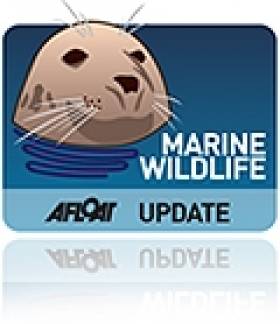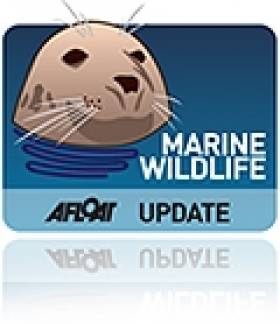Displaying items by tag: Sea Eagles
Rare Sea Eagles Survive Killarney National Park Fire
A pair of white-tailed sea eagles narrowly escaped the fire which ravaged Killarney National Park over the weekend.
As The Times Ireland edition reports today, the blaze came within 300 metres of the nest built by a pair introduced to Ireland under the State’s white-tailed sea eagle programme.
A south-easterly wind saved the predators- among Ireland’’s largest birds - which are understood to have survived the fire that tore through some 2,500 -3,000 hectares of Kerry upland.
Dr Allan Mee, manager of the project which originally brought 100 eagle chicks to Ireland from Norway from 2007 after a century of extinction, confirmed that the eagles had survived.
“This white-tailed sea eagle pair in Killarney national park has been successful every year since they came here in 2014,” Dr Mee said.
“They had been nesting on an island, but went back to their old nest – very near where the fire started – just last year,” he said.
However, he said that the fire was devastating for other wildlife.
Hen harriers and grouse which nest close to Purple Mountain, along with many animals and amphibians such as common lizards, would have perished or lost valuable habitats.
A separate fire on the Kerry-Limerick border destroyed one hen harrier nest and ravaged habitat hunted by three other pairs of the predatory bird.
Some 13 pairs of hen harriers among a total national population of 108 pairs live in this part of Kerry.
They are regarded as a good “indicator” species in terms of the health of an upland ecosystem, according to Fergal Monaghan, manager of the national Hen Harrier Project.
He works with some 1600 farmers in six special protection areas for hen harriers.
Monaghan urged a national co-ordinated “landscape-level” approach to be taken to try and protect vulnerable habitats from such fires.
The National Parks and Wildlife Service (NPWS) said it would not know the extent of damage to the overall site and indeed to species numbers of mammals, birds and other species until the habitats have been checked and analysis carried out by its staff when safe to do so.
Minister of State Malcolm Noonan said the NPWS and Garda would work together to investigate the cause of the fire.
The Irish Wildlife Trust (IWT) has criticised the lack of an active management plan for Killarney National Park.
#seaeagle – It is now possible to observe one of the first White Tailed Sea Eagles born in Ireland in over a century courtesy of a new marine wildlife viewing and Iinformation point that has been officially opened on the shores of Lough Derg in County Clare.
Located at Mountshannon Pier and operated by Mountshannon Community Council, the Golden Eagle Trust and Clare County Council, the new Viewing Point features telescopes and information and displays about the White Tailed Sea Eagles. The facility will remain open until the end of September.
Norway's Ambassador to Ireland, His Excellency Roald Næss joined Mayor of Clare Cllr. John Crowe in Mountshannon today in recognition of his country's close links with the Golden Eagle Trust's programme to reintroduce the bird to Ireland.
The Mountshannon breeding pair, a six-year-old male and five-year-old female, were collected as chicks on the island of Frøya off the west coast of Norway by the Golden Eagle Trust. The birds were released in Killarney National Park before relocating to Lough Derg in 2011. The pair, named Saoirse and Caimin, created history in 2013 when they reared the first chicks to fly from a nest in Ireland in 110 years. The pair successfully hatched another chick in late April of this year.
Mayor of Clare Cllr. John Crowe welcomed the introduction of the Viewing Point which he said provides the general public with "a unique opportunity to view the birds at close quarters without disturbing them".
He added: "The breeding success of the Mountshannon pair is in no small part down to the wonderful work of the Golden Eagle Trust, Clare County Council and Mountshannon Community Council, as well as the goodwill and support shown by the local community. This Viewing & Information Point will help to further safeguard these impressive birds and their nesting activities, as well as to promote their ecology and conservation."
Norwegian Ambassador to Ireland, His Excellency Roald Næss described the increase in the number of nesting pairs of White Tailed Sea Eagles in Ireland as "encouraging" and expressed his delight that Norway has played a central role in the reintroduction programme.
He continued: "Norway is home to one of the largest White Tailed Sea Eagle populations in the world and has been instrumental in helping organisations such as the Golden Eagle Trust to reintroduce the species to countries where the bird once flourished but is no longer found. Being able to view this breeding pair thrive here in County Clare is a tribute to everyone concerned and I hope the people who visit this Viewing Point truly value what is happening here."
Welcoming the official opening of the Viewing & Information Point, Dr. Allan Mee, White Tailed Sea Eagle project manager, commented: "We are very conscious of the risk of disturbing the birds especially during nesting periods, so we warmly welcome this structure which is purpose built and designed specifically for the purposes as a Bird Viewing and Information Point. It will help put Mountshannon on the map as the destination to come and enjoy perhaps Ireland's largest and most spectacular breeding bird. To have a nesting pair of eagles here on our doorstep is a unique and one that the local community in Mountshannon will I'm sure help nurture into the future".
The Viewing Point will be maintained by Mountshannon Community Council, whose Chair John Harvey said: "Since the White Tailed Sea Eagles first arrived here three years ago, members of the local community have given tremendous support to the Golden Eagle Trust to ensure the birds were given every possible opportunity to thrive. The Community Council looks forward to welcoming people to the village and the Viewing Point, which we regard as a wonderful addition to the local tourism infrastructure."
Ireland's Sea Eagles In Photos From Birth To Death
#MarineWildlife - RTÉ News has posted some of Nigel Beers-Smith's wonderful photographs documenting Ireland's first native white-tailed eagles for over 100 years, one of which was found dead recently in shocking circumstances.
As The Irish Times reports, the male white-tailed or sea eagle was last seen on the eastern shore of Lough Derg in January before it was found dead from gunshot wounds in a remote part of Co Tipperary following a tip-off from the public.
The eagle was one of two reared by the nesting pair spotted on Bushy Island in Lough Derg nearly two years ago - marking the first time in over a century that white-tailed eagles had fledged in Ireland.
Minister for Arts, Hertiage and the Gaeltacht Jimmy Deenihan said he was "shocked" by the crime, which is a "significant blow" to the sea eagle reintroduction programme started in 2007.
“It is absolutely incomprehensible that someone would shoot one of these magnificent birds but even more shocking is that one of the first two Irish-bred eagles has been shot only seven months after leaving the nest," added reintroduction project manager Dr Allan Mee.
The project has already suffered from poisoning incidents, such as last year's discovery of two dead white-tailed eagles in Kerry and West Cork - both the result of consuming suspected tainted carrion.
The Irish Times has much more on the store HERE.
White-Tailed Sea Eagles Found Dead in Southwest
#MarineWildlife - RTÉ News reports on the discovery of two dead white-tailed sea eagles in Kerry and West Cork.
The bird found washed up near Glengariff in West Cork two weeks ago was confirmed as poisoned after a post-mortem at the State Laboratory in Celbridge.
According to its electronic tag, the female sea eagle was released in Kerry more than two years ago.
Meanwhile a second bird found in south Kerry earlier this week is also believed to have been died as a result of eating poisoned carrion - an illegal method sometimes employed to control crows and foxes preying on lambs.
A protected species under Irish law, some 100 while-tailed sea eagles were reintroduced to the wild in Killarney National Park from 2007 to 2011. Since that time more than a quarter have been found dead, with 12 of those cases confirmed as poisonings.































































